新人教版七年级上册英语教案
最新人教版七年级英语上册教案(完整版)
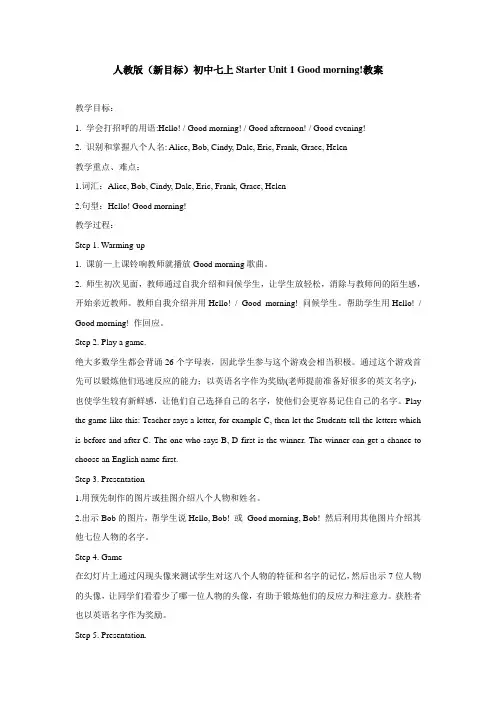
人教版(新目标)初中七上Starter Unit 1 Good morning!教案教学目标:1. 学会打招呼的用语:Hello! / Good morning! / Good afternoon! / Good evening!2. 识别和掌握八个人名: Alice, Bob, Cindy, Dale, Eric, Frank, Grace, Helen教学重点、难点:1.词汇:Alice, Bob, Cindy, Dale, Eric, Frank, Grace, Helen2.句型:Hello! Good morning!教学过程:Step 1. Warming-up1. 课前—上课铃响教师就播放Good morning歌曲。
2. 师生初次见面,教师通过自我介绍和问候学生,让学生放轻松,消除与教师间的陌生感,开始亲近教师。
教师自我介绍并用Hello! / Good morning! 问候学生。
帮助学生用Hello! / Good morning! 作回应。
Step 2. Play a game.绝大多数学生都会背诵26个字母表,因此学生参与这个游戏会相当积极。
通过这个游戏首先可以锻炼他们迅速反应的能力;以英语名字作为奖励(老师提前准备好很多的英文名字),也使学生较有新鲜感,让他们自己选择自己的名字,使他们会更容易记住自己的名字。
Play the game like this: Teacher says a letter, for example C, then let the Students tell the letters which is before and after C. The one who says B, D first is the winner. The winner can get a chance to choose an English name first.Step 3. Presentation1.用预先制作的图片或挂图介绍八个人物和姓名。
(新)人教版七年级英语上册教学设计(全册,精品)
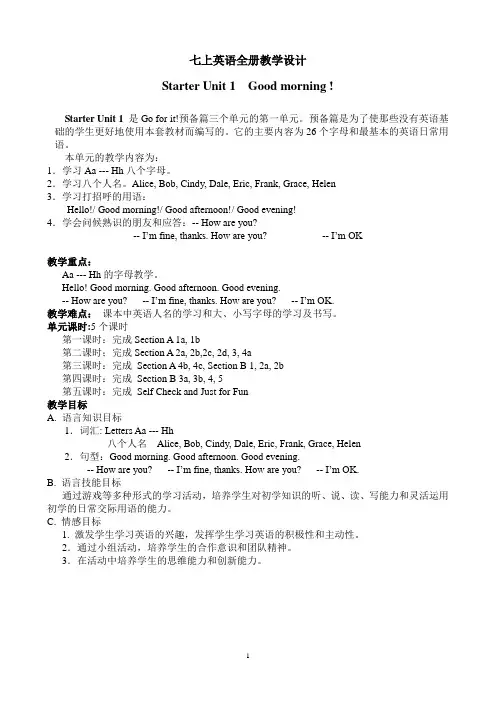
七上英语全册教学设计Starter Unit 1 Good morning !Starter Unit 1是Go for it!预备篇三个单元的第一单元。
预备篇是为了使那些没有英语基础的学生更好地使用本套教材而编写的。
它的主要内容为26个字母和最基本的英语日常用语。
本单元的教学内容为:1.学习Aa --- Hh八个字母。
2.学习八个人名。
Alice, Bob, Cindy, Dale, Eric, Frank, Grace, Helen3.学习打招呼的用语:Hello!/ Good morning!/ Good afternoon!/ Good evening!4.学会问候熟识的朋友和应答:-- How are you?-- I’m fine, thanks. How are you? -- I’m OK教学重点:Aa --- Hh的字母教学。
Hello! Good morning. Good afternoon. Good evening.-- How are you? -- I’m fine, thanks. How are you? -- I’m O K.教学难点:课本中英语人名的学习和大、小写字母的学习及书写。
单元课时:5个课时第一课时:完成Section A 1a, 1b第二课时;完成Section A 2a, 2b,2c, 2d, 3, 4a第三课时:完成Section A 4b, 4c, Section B 1, 2a, 2b第四课时:完成Section B 3a, 3b, 4, 5第五课时:完成Self Check and Just for Fun教学目标A.语言知识目标1.词汇: Letters Aa --- Hh八个人名Alice, Bob, Cindy, Dale, Eric, Frank, Grace, Helen2.句型:Good morning. Good afternoon. Good evening.-- How are you? -- I’m fine, thanks. How are you? -- I’m OK.B. 语言技能目标通过游戏等多种形式的学习活动,培养学生对初学知识的听、说、读、写能力和灵活运用初学的日常交际用语的能力。
七年级上册英语教案人教版免费

七年级上册英语教案人教版免费(经典版)编制人:__________________审核人:__________________审批人:__________________编制单位:__________________编制时间:____年____月____日序言下载提示:该文档是本店铺精心编制而成的,希望大家下载后,能够帮助大家解决实际问题。
文档下载后可定制修改,请根据实际需要进行调整和使用,谢谢!并且,本店铺为大家提供各种类型的经典范文,如工作总结、述职报告、策划方案、演讲致辞、合同协议、条据文书、教案资料、好词好句、作文大全、其他范文等等,想了解不同范文格式和写法,敬请关注!Download tips: This document is carefully compiled by this editor. I hope that after you download it, it can help you solve practical problems. The document can be customized and modified after downloading, please adjust and use it according to actual needs, thank you!Moreover, our store provides various types of classic sample essays for everyone, such as work summaries, job reports, planning plans, speeches, contract agreements, doctrinal documents, lesson plans, good words and sentences, complete essays, and other sample essays. If you want to learn about different sample formats and writing methods, please pay attention!七年级上册英语教案人教版免费最新七年级上册英语教案人教版免费(8篇)作为一位不辞辛劳的人·民教师,通常会被要求编写教案,那么关于七年级上册英语教案怎么写呢?以下是本店铺准备的一些七年级上册英语教案人教版免费,仅供参考。
七年级英语上册人教版全册教案
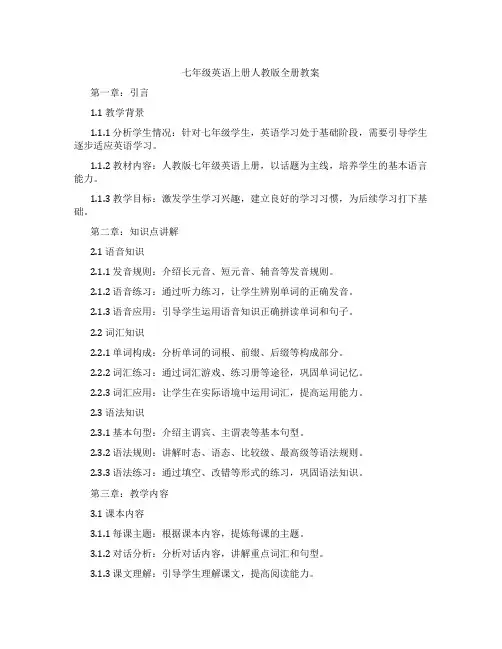
七年级英语上册人教版全册教案第一章:引言1.1 教学背景1.1.1 分析学生情况:针对七年级学生,英语学习处于基础阶段,需要引导学生逐步适应英语学习。
1.1.2 教材内容:人教版七年级英语上册,以话题为主线,培养学生的基本语言能力。
1.1.3 教学目标:激发学生学习兴趣,建立良好的学习习惯,为后续学习打下基础。
第二章:知识点讲解2.1 语音知识2.1.1 发音规则:介绍长元音、短元音、辅音等发音规则。
2.1.2 语音练习:通过听力练习,让学生辨别单词的正确发音。
2.1.3 语音应用:引导学生运用语音知识正确拼读单词和句子。
2.2 词汇知识2.2.1 单词构成:分析单词的词根、前缀、后缀等构成部分。
2.2.2 词汇练习:通过词汇游戏、练习册等途径,巩固单词记忆。
2.2.3 词汇应用:让学生在实际语境中运用词汇,提高运用能力。
2.3 语法知识2.3.1 基本句型:介绍主谓宾、主谓表等基本句型。
2.3.2 语法规则:讲解时态、语态、比较级、最高级等语法规则。
2.3.3 语法练习:通过填空、改错等形式的练习,巩固语法知识。
第三章:教学内容3.1 课本内容3.1.1 每课主题:根据课本内容,提炼每课的主题。
3.1.2 对话分析:分析对话内容,讲解重点词汇和句型。
3.1.3 课文理解:引导学生理解课文,提高阅读能力。
3.2 拓展内容3.2.1 相关话题:针对课本内容,拓展相关话题。
3.2.2 听力练习:选择合适的听力材料,提高学生听力水平。
3.2.3 口语表达:组织口语交流活动,提高学生口语表达能力。
第四章:教学目标4.1 知识目标4.1.1 掌握基本的语音、词汇和语法知识。
4.1.2 能够听懂、说出一日常用语。
4.1.3 理解课本内容,具备一定的阅读和写作能力。
4.2 能力目标4.2.1 提高学生的听、说、读、写四项基本技能。
4.2.2 培养学生的语言运用能力和团队协作能力。
4.2.3 培养学生的跨文化交际意识。
人教版七年级上册英语全英教案
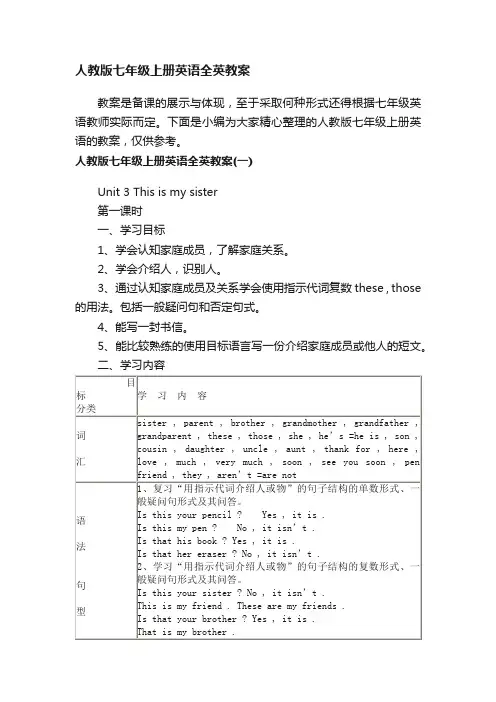
人教版七年级上册英语全英教案教案是备课的展示与体现,至于采取何种形式还得根据七年级英语教师实际而定。
下面是小编为大家精心整理的人教版七年级上册英语的教案,仅供参考。
人教版七年级上册英语全英教案(一)Unit 3 This is my sister第一课时一、学习目标1、学会认知家庭成员,了解家庭关系。
2、学会介绍人,识别人。
3、通过认知家庭成员及关系学会使用指示代词复数these , those 的用法。
包括一般疑问句和否定句式。
4、能写一封书信。
5、能比较熟练的使用目标语言写一份介绍家庭成员或他人的短文。
二、学习内容三、朗读单词1. sister n. 姐;妹2. parent n. 父或母3. brother n. 兄;弟4. grandmother n. 祖母;外祖母5. grandfather n. 祖父;外祖父6. grandparent n. 祖父/ 母;外祖父/母7. these pron . & adj.这些8. those pron . & adj.那些9. she pron .她10. he’s =he is11. son n.儿子12. cousin n.堂(表)兄弟;堂(表)姐妹13. daughter n. 女儿14. uncle n.叔;伯;舅;姨父;姑夫15. aunt n. 姨母;姑母;伯母;婶母16. thank for为……而感谢17. here adv.在这里;向这里18. love v.爱;热爱19. much adv. 很;非常20. very much 很;非常21. soon adv.不久22. see you soon ,再见。
23. pen friend 笔友24. they pron. 他(她;它)们25. aren’t =are not四、任务示范Show the Ss some pictures , point at the pictures and tell them like this :This is my father / mother / brother / sister ……That’s my sister / grandmother / grandfather ……Then ask the Ss to bring their families’ pictures and introduce people in this way .五、布置作业1、请同学们反复朗读单词,并自查能记住多少单词。
新人教版七年级英语上册全册教案
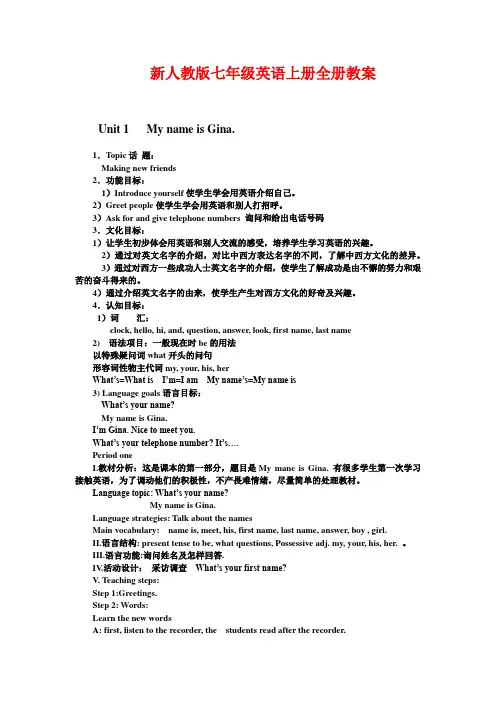
新人教版七年级英语上册全册教案Unit 1 My name is Gina.1.Topic话题:Making new friends2.功能目标:1)Introduce yourself使学生学会用英语介绍自己。
2)Greet people使学生学会用英语和别人打招呼。
3)Ask for and give telephone numbers 询问和给出电话号码3.文化目标:1)让学生初步体会用英语和别人交流的感受,培养学生学习英语的兴趣。
2)通过对英文名字的介绍,对比中西方表达名字的不同,了解中西方文化的差异。
3)通过对西方一些成功人士英文名字的介绍,使学生了解成功是由不懈的努力和艰苦的奋斗得来的。
4)通过介绍英文名字的由来,使学生产生对西方文化的好奇及兴趣。
4.认知目标:1)词汇:clock, hello, hi, and, question, answer, look, first name, last name2) 语法项目:一般现在时be的用法以特殊疑问词what开头的问句形容词性物主代词my, your, his, herWhat‘s=What is I‘m=I am My name‘s=My name is3) Language goals语言目标:What‘s your name?My name is Gina.I‘m Gina. Nice to meet you.What‘s your telephone number? It‘s….Period oneI.教材分析:这是课本的第一部分,题目是My mane is Gina. 有很多学生第一次学习接触英语,为了调动他们的积极性,不产畏难情绪,尽量简单的处理教材。
Language topic: What‘s your name?My name is Gina.Language strategies: Talk about the namesMain vocabulary: name is, meet, his, first name, last name, answer, boy , girl.II.语言结构: present tense to be, what questions, Possessive adj. my, your, his, her. 。
人教版初一英语教案
人教版初一英语教案【篇一:人教版七年级上册英语全册教案】新目标英语(go for it)七年级上全册教案unit 1-12unit 1 my name’s ginaperiod one课前准备教师:准备游戏时所用的图片(食物、蔬菜、动物)。
学生:准备表演时所需道具(服装、假发)。
教学设计step one :present the sentence patterns.1. play a game “how many words do you know?”(利用小游戏调动学生的积极性,同时通过对冠军的介绍引出本课。
)teacher: after the study of the first three starters, i thinkmost of the students must have known a lot of words. how manywords do you know? let’s play a game to see who know? let’s play a game to see who knows the most.(divide all the students into several groups and show a picture (图片略) to them with the computer. every group can choose two students to join. they are asked to come to the blackboard and write down the words in 30 seconds.)(group 2 is the champion group. they can write 11 words.)2. introduce the champion group to the class.(引课方式贴近生活,学生易于接受)teacher: congratulations, now group 2 is the champion. but i don’t know your names. would you like to introduce y ourselves to us?s1 s2:yes.s1:hello.my name is li lei. nice to meet you.ss: hello, li lei. nice to meet you ,too.ss: hello! what’s your name?s2:i’m sun ping. how do you do?ss: how do you do ?step two: drills.1. make introductions.(通过句型的操练使学生更加熟练掌握所学的句式。
全新人教版七年级英语上册全英文教案(全册 全英文p)
全新人教版七年级英语上册全英文教案(全册全英文全新人教版七年级英语上册全英文教案(全册全英文共132页)Starter Unit 1Good morning!Period 1 (1a~2e)Teaching important points【教学重点】1.Key words & phrases:good,morning,hi,hello,HB,CD,BBC2.Key sentences:Good morning!Teaching difficult points【教学难点】Grasp the letters Aa-Hh and learn to recognize the English names.Teaching aids【教具】a computer and some cardsTeaching procedures and ways【教学过程及方法】★Step Ⅰ Revision and lead-in复习导入Greet the students and lead in the new lesson.T:Good morning,everyone!My name is…I am your English teacher.You can call me Miss/Ms./Mr. …(Walking to a boy)What's your name?Boy:My name is Li Tao.T:Good morning,Li Tao.Boy:Good morning,Ms./Mr. …(Help the student to respond correctly if necessary.)The teacher writes “Good morning,Li Tao.”on the blackboard.★Step Ⅱ Self-studying and guiding自学指导Self-study guide 1:Self-study the new words and English names:good,morning,hi,hello,Alice,Bob,Cindy,Dale,Eric,Frank,Grace,Helen.Learn to pronounce them according to the phonetic symbols(音标).And you can listen to the tapes to help you pronounce them correctly or ask others for help.Self-study guide 2:Try reading the sentences in 1a and try to tell boys' names from girls' names.Self-study guide 3:Self-study 2c and learn to write the eight letters.Questions for thinking:1.Do you know how to greet people in the morning?2.Do you know how to write the eight letters Aa,Bb,Cc,Dd,Ee,Ff,Gg,Hh?The teacher walks around the classroom to watch and help the students study while the students are self-studying.Time for questions:Discuss the writing of the eight letters.★Step Ⅲ Check up检查核对Check up 1:Words teaching:Ask a few students to read the new words and help them correct the mistakes in pronunciation if necessary.Check up 2:Ask some students to make a conversation with their partner and see if they can respond correctly.And ask students to fill in the blanks:Boys' names:________________________________________________________________________ Girls' names:________________________________________________________________________Check up 3:Write the small letters for these big letters:A____B____C____D____E____F____G____H____★Step Ⅳ Cooperative inquiry合作探究1.Listening (1b)Play the recording of 1a,students listen and repeat.2.Pair workPractice the conversations in the picture and then greet your partner.(1c)Sample:A:Good morning,Zhang Wen!/Hello,Zhang Wen!B:Good morning,Li Yan!/Hello,Li Yan!3.Act outAsk some pairs of students to act out their dialogs in front of the class.4.Finish 2a and 2b.5.Discussion (2e)Talk about what these letters HB,CD,BBC mean.★Step Ⅴ Practice练习Write the missing big letter or small letter for each pair.(2d)★Step Ⅵ Test测试Choose the best answer.()1.书写英文字母时,占三格的是________。
七年级上册英语教案人教版5篇
七年级上册英语教案人教版5篇最新七年级上册英语教案人教版5篇教案是教师教学过程中必不可少的指导工具,能够提升教学质量和效果。
下面是小编为大家整理的七年级上册英语教案人教版,如果大家喜欢可以分享给身边的朋友。
七年级上册英语教案人教版篇1Language goalIn this unit, students learn to talk about jobs.New languageWhat do you do I m a reporterWhat does he do. He s a student.What do you want to be I want to be an actor .What does she want to be She wants to be a police officernames of jobs and professionsSection ABrainstorm with students a list of jobs that friends or relatives do. ( Brainstorming is an activity in which you set a topic and students say whatever words they can think of relating to that topic.) Write the word jobs on the board and list all the jobs students mention.Point to the jobs one by one and ask students to say what ever they can about these jobs. Accept single word answers or simple sentences such as, It s fun. It s a good job.la This activity introduces the key vocabulary.Focus attention on the art. Ask students to tell what they see in each scene. Ask students to name as many of the jobs shown as theycan. Then point to a scene, name the job, and ask students to repeat. Point to the numbered list of words. Say each one and ask students to repeat.Then ask students to match each word wllfa one of the scenes. Say, Write the letter of each scene next to one of the ivords. Point tothe sample answer.1 b This activity gives students practice in understanding thetarget language in spoken conversation.Point to the different people shown in the picture.Ask various students to tell what they do as you point to each one,Say, Now you will hear three conversations. The conversations are about three of the people in this picture.Play the recording the first time. Students only listen.Play the recording a second time. This time ask students to write a number 1 next to the person being talked about in conversation 1. Have students put a 2 and 3 next to the people being talked about in conversations 2 and 3.Correct the answers.1 c This activity provides guided oral practice using the target language-Ask a student to read the example conversation with you. Hold upthe book and point to the doctor in the picture.Say, Now work with your partner. Make your own conversations about the picture. You can use sentences like the ones in activity 1b.Say a dialogue with a student. Point to a picture of one of the people. Guide the student to answer using one of the words inactivity 1a.As students work in pairs, move around the room monitoring theirwork. Oner language or pronunciation support as needed.2a This activity gives students practice in understanding thetarget language in spoken conversation.Ask students to look at the three pictures. Ask different students to tell you what they sec in each picture. What are the people doing What jobs do they havePlay the recording the first time. Students only listen.Say, You will hear conversations about the people in these pictures.Play the recording a second time. Say, Write the number of each conversation below the picture of the person being talked about.Correct the answers.2b This activity gives students practice in understanding thetarget language in spoken conversation.Point to the three headings in the chart and read the headings to the class. Ask students, What does wants to be mean (It is not the Job the person lias now. It is the job the person wants in the future.)Play the recording the first time. Students only listen.Say, You wiU hear about the people in these pictures. You will hear the job they haw now and the job they want in the future.Play the recording a second time. This time ask students to fill in the blanks with the jobs the people have now and the ones they wantin the future. Point out the sample2c This activity provides guided oral practice using the target language.Point out the pictures in activity 2a. Ask who each person is. (They are Susan s brother. Anna s mother, and Tony s father.)Say, Now work with your partner. Ask and answer questions about thepictures. Ask, What does he or she do Then ask, What does he or she want to beSay a dialogue with a student. Point to Anna s mother and then to the example in the speech balloons. Practice the dialogue with a student.As students work In pairs, move around the room monitoring their work. Offer language support as needed.3a This activity introduces the names for the places where people work, and gives reading practice using the target language.Call attention to the pictures. Ask students to read the name for each place. As they name each place, write the word on the board and-ask the class to repeat it.Point out the list of jobs with the numbers next to each. Then call attention to the people in the pictures and the speech bubbles. Point out the sample answer and have a student read out the speech bubble. Ask students to work alone. Say, Write the number of each job in the square next to each workplace.Check the answers.3b This activity provides guided oral practice using the target language.Point out the pictures in activity 3a. Ask students to name the workplace shown In each picture.Then point out the conversation in the speech bubbles. Ask two students to read It to the class.Say, Wow work with a partner. First practice the conversation in the picture. Then make new conversations. Use jobs and places from activity 3a.Say a dialogue with a student. Point to the word waiter in activity3a and then to the picture of the restaurant. Ask a student. Where does he work Guide the student to answer using the correct place: He works in a restaurant.Then ask. What does he do and guide the student to answer, He s a waiter.As students work in pairs, move around the room monitoring their work. Offer language support as needed.4 This activity provides listening and speaking practice using the target language.Call attention to the pictures in the book showing how to play the game. Say, You will draw a picture of someone working. Other students will ask questions about the kind of job you are drawing. After two questions someone can try to guess the job.Demonstrate by drawing a picture on the board of a stick figure reporter. Add details (microphone, notebook,etc.) until students guess what job it is.Ask a student to go to the board. Say, Draw a picture of a person working. If necessary, help the student add details that show the job the person is doing. He or she can add a bank interior to show that the person is a bank clerk. A student could also use an eye chart on the wall to show that the place is a doctor s office and the personis a doctor.Ask two different students to ask questions about the Job, and then ask a third student to guess what job it is.Play the game using drawings by several different students.Alternative: If you do not want students to move from their seats, then you can ask them to do this activity sitting down in groups of four. They will need pieces of paper on which to draw their pictures. They will also need pencils.Section BNew languageWords that describe jobs, such as exciting, dangerous,boring, difficult, busy, funAdditional materials to bring to class:help wanted ads from an English-language newspaper1 a This activity introduces the key vocabulary.Focus attention on the six pictures. Ask, What job does the person have Where does the person ivnrkPoint out the numbered list of words. Say each one and ask students to repeat. Then use simple explanations and short sample sentences to help students understand what each word means. For example, Exciting means very interesting and very fast-moving. A police officer has an exciting job. The job is always changing. Something is always happening. For dangerous you might say, Dangerous means not safe. You might be hurt or killed in a dangerous job.Then ask students to match each word with one of the pictures. Say, Write the letter of each picture next to one of the words. Point out the sample answer.Check the answers.1 b This activity provides guided oral practice using the target language.Call attention to the picture In this activity and ask a student to read the statement to the class. Then point to the picture of the police officer and say. It s an exciting job. Ask the class to repeat. Then say, What else can you say about being a police officer Someone may answer, It s a dangerous job. Ask the class to repeat each correct answer.Then ask students to work in pairs. Suggest that they each point to the pictures of the workers and make statements about them. As students practice, move around the classroom monitoring their work.1 c This activity provides an opportunity for oral practice.Say, Name some of the jobs from this unit. Write this list of jobs on the board. Say, Can you name some other jobs Add any new jobs to the list.Ask some students to make statements about Jobs on the list using the words in activity la. You may wish to write some of the sentences on the board so that students can copy the sentences into their notebooks.2a This activity provides listening and writing practice with the target language.Call attention to the two headings and ask a student to read die headings to the class.Point out the blank lines where students will write the name of a job (under the words wants to be).Play Ihe recording the first time. Students only listen.Say, Now I will play the tape again. This time write the name of a job under the words wants to be.2b This activity provides listening and writing practice with the target language,Call attention to the second heading and ask a student to read it to the class. Say, This time you will unite why each person wants the job.Play the recording again. Students only listen.Then say, Now I will play the tape again. This time write the reason the person wants the job under the word WhyPlay the recording. Students write their answers.Check the answers.2C This activity provides open-ended oral practice using the target language.Say, What do you want to be What words describe each job Help the class make up a list of jobs they might like to do. As students suggest possible jobs, ask the class to suggest words to describe them. Use a bilingual dictionary, if necessary, to find the names of jobs and words to describe each one.Then ask students to work in small groups. They tell each otherwhat they want to do and why. Encourage students to use dictionariesif necessary. Move from group to group offering assistance as needed. Ask individual students to tell the class about what they want tobe and why.3a This activity provides reading and writing practice using the target language.Call attention to the three newspaper ads and read these ads to the class. Say blank each time you come to a blank line.Then read each ad again separately, pausing to allow students toask questions about anything they don t understand. For example, in the first ad, students may not know that working late means workingat night. To work hard means to use a lot of energy to do the job.Ask students to fill In (he blanks in the ads using the words actor, reporter, and waiter.Check the answers.3b This activity provides reading and writing practice using the target language.Call attention to the newspaper ad and ask a student to read it,saying blank for each blank line.Ask students to fill in the blanks using words from This section. Say,Look at the pictures next to each blank line. The pictures will help you guess the correct word.Suggest that they look at the names of jobs and the words that describe jobs in the first part of Section B.Check the answers,3c This activity provides writing practice using the targetlanguage.Point out the blank strip of newspaper where students can write their own ads.Ask one or two students, What are you going to write about Repeat each of the students sentences and ask the class to repeat the sentences after you. For example: Do ^OM want an interesting but dangerous job Do you want to meet new people We need a police officer.Call the Smithtown Police Station at 555-2323.Ask students to read their ads to a partner. Ask the pairs to correct each other s work.4 This activity provides guided oral practice using thetarget language.Ask two students to read the conversation in the speech bubbles. Answer any questions students may have about it.Then say, New please work in groups. Ask efuestions to find out what jobs each person wrote about. You can use sentences like the ones we just read.As students ask questions, move from group to group. Rephrase any incomplete or incorrect questions.Also rephrase any inaccurate answers.七年级上册英语教案人教版篇2Unit 3 Language in use课型 Revision and application教材分析 Unit 3 对“自我介绍和获取信息”的功能句式进行综合训练:谈论自己或朋友的情况(活动1);根据提示完成介绍图片中人物情况的句子;填表、匹配复习表示国家、民族及人物活动的词汇。
新人教版七年级英语上册教案
新人教版七年级英语上册教案教师独立钻研教材,创造性进行教学设计,把对教材的理解,进行创造性加工的东西备在书上,而在教案中重点突出程序与环节的设计、教法与学法的运用。
下面是小编为大家精心整理的新人教版七年级英语上册教案,仅供参考。
新人教版七年级英语上册教案(一)Unit 6 Do you like bananas?单元整体说明单元教材分析本单元主要学习动词like的肯定句、否定句的用法;动词like的一般疑问句的用法以及肯定与否定的回答。
本单元以介绍食物,谈论喜欢与厌恶为主题,设计了三个任务:先是搜集、利用图片来介绍有关的食物,学习一些食物名词;然后是学习询问对方喜欢与不喜欢的食物,掌握动词like的一般疑问句的构成以及它的肯定、否定的回答;最后是用所学过的食物名词制定一次野炊活动的采购单。
本单元的重点内容仍然是行为动词在一般现在时句子中的使用,应该是上一个单元内容的延伸,通过本单元的教学,学生应初步掌握行为动词一般现在时的肯定句、否定句、一般疑问句的构成以及简单的回答。
单元知识系统(树)Do you/they like salad? Yes,I/they do./No,I/they don’t.Does he/she like salad? Yes,he/she does./No,he/she doesn’t.I/They like oranges. I/They don’t like oranges.He/She likes ice cream. He/She doesn’t like bananas.单元总体目标学会使用动词like询问对方喜欢与不喜欢的食物;学会谈论自己与他人早、中、晚餐喜欢吃的食物;学会营养配餐并能够制作购物单和调查表。
单元重难点一览重点 难点1.复习词汇:like2.词汇:banana ,hamburger ,tomato ,broccoli ,French fries ,orange ,ice cream ,salad ,strawberry ,breakfast ,lunch , dinner ,egg ,apple ,chicken ,fruit ,vegetable 3.句型:Do you/they like salad? Yes ,I/they do ./No ,I /they don’t. Does he/she like salad? Yes ,he/she does ./No ,he/she doesn’t.I/They like oranges . I/They don’t likeoranges .He/She likes ice cream . He/She doesn’t likebananas .语法重点:动词like 一般现在时的肯定句、否定句和一般疑问句的用法以及肯定与否定的回答。
- 1、下载文档前请自行甄别文档内容的完整性,平台不提供额外的编辑、内容补充、找答案等附加服务。
- 2、"仅部分预览"的文档,不可在线预览部分如存在完整性等问题,可反馈申请退款(可完整预览的文档不适用该条件!)。
- 3、如文档侵犯您的权益,请联系客服反馈,我们会尽快为您处理(人工客服工作时间:9:00-18:30)。
新人教版七年级上册英语教案
Unit7 How much are these socks?
New words: socks, T-shirt, pants, shoes, shorts, sweater, skirt, bag, dollars, black, white, green, red, blue, big, small, short, ling, numbers 10-31
— How much is the blue T-shirt?
It’s 10 dollars.
OK, I’ll take it.
— Thank you..
— You’re welcome.
— How much are these sweaters?
They’re eight dollars.
What color do you want?
I want green.
Here you are.
I’ll take it/them.
— How much is the blue T-shirt?
It’s 10 dollars.
OK, I’ll take it.
— Thank you..
— You’re welcome.
— How much are these sweaters?
They’re eight dollars.
What color do you want?
I want green.
Here you are.
I’ll take it/them.
Unit7 How much are these socks?
New words: red, green, black, white, blue, yellow -- What color do you want?
I want blue.
Here you are.
Thank you! I’ll take it. ……
-- What color do you want?
I want blue.
Here you are.
Thank you! I’ll take it. ……
Unit7 How much are these socks?
New words: ten, eleven, twelve, thirteen, fourteen, etc. -- How much is the green sweater?
-- It’s 20 dollars…
-- How much is the green sweater?
-- It’s 20 dollars…
Unit7 How much are these socks?—Can I help you? — Yes, please. I want……..
Ⅳ. Closing down by reviewing the main points
How much are the shorts?
They are 10 dollars.
How much is the blue sweater?
It’s 25 dollars.
I’ll take it.
We have sweaters at a very good price—only 25 dollars.
You can buy socks for only 2 dollars each.。
